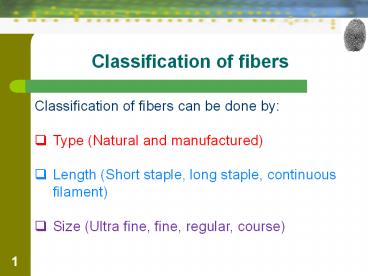Classification of fibers PowerPoint PPT Presentation
1 / 15
Title: Classification of fibers
1
Classification of fibers
- Classification of fibers can be done by
- Type (Natural and manufactured)
- Length (Short staple, long staple, continuous
filament) - Size (Ultra fine, fine, regular, course)
2
(No Transcript)
3
Fiber Classification Natural Fibers
- Animal fibers (made of proteins)
- Wool from sheep, cashmere and mohair from goats,
angora from rabbits, and hair from alpacas,
llamas, and camels are commonly used in textiles.
- Shimmering (shine) silk from caterpillar (worm)
cocoons is longer and not as easily shed. - Triangular structure scatters light like a prism
4
Fiber Classification Natural Fibers
- Plant fibers (made of the polymer cellulose)
- Seeds, fruits, stems leaves
- can absorb water
- are insoluble in water
- are very resistant to damage from harsh chemicals
- can only be dissolved by strong acids
- can be common at crime scenes because they become
brittle over time
5
Fiber Classification Natural Fibers
- Plant fibers
- Cotton from seedpods is the plant fiber most
commonly used in textiles (shown above). - Can be woven dyed easily
- Coir from coconuts is durable.
- Hemp, jute, and flax from stems grow in bundles.
- Flax is the most common, found in linen
- Manila and sisal from leaves deteriorate more
quickly. - Manila is from abaca leaves, related to the
banana tree
6
Cotton
- Cellulosic fiber
- From bolls (seed pods) growing on bushes
- Comfortable
- Soft and durable
- Porous or leaky, cool to wear
- Environmentally friendly cotton can be grown in
a range of colors
Many cottons are also blended with other natural
fibers, such as linen, for particular properties
7
Flax (Linen) (Tisi)
- Worlds oldest textile fiber
- Cellulosic fiber from stem of flax plant
- Stiff, wrinkles (folds) easily
- Absorbent (leaky), cool to wear in heat
- Other uses
- Dish towels
- Tablecloths
Flax is the fiber name linen is the fabric name.
8
Fiber Classification Natural Fibers
- Mineral Fibers
- Fiberglass is a fibrous form of glass.
- Asbestos is a naturally occurring mineral with a
crystalline structure. - Very durable
- Pipe coverings, brake linings, ceiling tiles,
floor tiles, fire-resistant work clothes,
shingles, siding, insulation - When its broken, fibers shatter into tiny
fragments that become airborne. If inhaled, they
cut the lungs and scar tissue may become
cancerous.
9
Fiber Classification Synthetic (artificially
produced) Fibers
- Until the nineteenth century only plant and
animal fibers were used to make clothes and
textiles. - Half the products produced today are artificially
produced. - Regenerated fibers or Polymers
- Polymers are monomers joined together
- Artificially produced fibers include rayon,
acetate, nylon, acrylics, and polyesters.
10
Fiber Classification Synthetic (artificially
produced) Fibers
- Regenerated Fibers (derived from cellulose)
- Rayon is the most common of this type of fiber.
It can imitate (duplicate) natural fibers, but it
is stronger. - Celenese is cellulose chemically combined with
acetate and is often found in carpets. - Polyamide nylon is cellulose combined with three
acetate units, is breathable, lightweight, and
used in performance clothing.
11
Fiber Classification Synthetic (artificially
produced) Fibers
- Synthetic Polymer Fibers
- Petroleum is the basis for these fibers, and they
have very different characteristics from other
fibers. - Non-cellulose
- Monomers in large vats are joined together to
form polymers. The fibers produced are spun
together into yarns. - They have no internal structures, and under
magnification they show regular diameters.
12
Fiber ClassificationSynthetic (artificially
produced) Fibers
- nylon
- Examples of synthetic polymer fibers
- Polyesterfound in polar fleece,
wrinkle-resistant, and not easily broken down by
light or concentrated acid added to natural
fibers for strength. - Nyloneasily broken down by light and
concentrated acid otherwise similar to
polyester. - Acrylicinexpensive, tends to ball easily, and
used as an artificial wool or fur. - Olefinshigh performance, quick drying, and
resistant to wear.
13
Natural Synthetic Comparison
- Man-made fibers are not damaged by microorganisms
like natural fibers - Man-made fibers can deteriorate in bright
sunlight and melt at a lower temperature than
natural fibers.
14
Comparison of Natural and Synthetic Fibers
- Visual Diagnostics of Some Common Textile Fibers
- under Magnification
15
Thanks to all
www.ceplecture.yolasite.com

